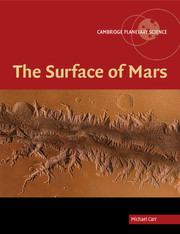8 - Ice
Published online by Cambridge University Press: 12 August 2009
Summary
Ice has likely played many different roles in the evolution of the surface, depending on where and when the ice was located. One can think of ice as being in two reservoirs: one on the surface exchanging with the atmosphere and with the upper meter or so of the surface, and one deep below the surface. The amount at the surface is rather modest, probably no more than 50 m spread over the whole planet, and most is at the poles (Chapter 10). We have known that the northern remnant cap is composed of water ice since the time of Viking (Farmer et al., 1976; Kieffer et al., 1976). Suspicion from that time that a water-ice cap also underlies the remnant CO2 cap in the south has recently been confirmed (Byrne and Ingersoll, 2003b; Bibring et al., 2004). The amount buried deep in the ground is probably substantially larger than the amount on the surface. While we have no direct measure of how much is there, radar sounding suggests that significant amounts may be present (Picardi et al., 2005). In the present epoch, ice is continually being redistributed across the surface and exchanged with the near-surface materials as a result of seasonal changes in insolation and astronomically induced changes (Mellon and Jakosky, 1995). During periods of high obliquity, much of the water now locked up in the poles may move to lower latitudes, and there may be a redistribution of ice that resides within a few meters of the surface.
- Type
- Chapter
- Information
- The Surface of Mars , pp. 173 - 192Publisher: Cambridge University PressPrint publication year: 2007

